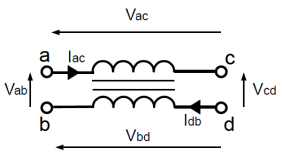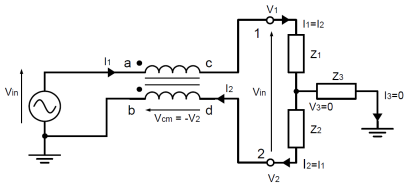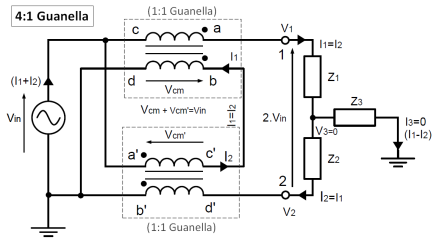What's Wrong with the 4:1 Guanella:
Fundamentally, there is nothing actually “wrong” with the 4:1 Guanella Balun.
The problem is, most people fail to realize its Common Mode Impedance (CMI) characteristics and understand where it might prove to be inadequate.
In order to understand this, we will walk through the basics of a simple RF choke, a 1:1 Guanella (balun or choke), and then a 4:1 Guanella balun.
A Simple RF Choke:
A Simple RF Choke consists of a transmission line wrapped into a coil. It may be made of bifilar wires, coax cable, or twisted-pair wires. In order to increase the inductance, it is often wound on a ferrite rod or a ferrite Toroid.
Increasing the number of turns in the coil, or the permeability of the ferrite core increases the amount of its Common Mode Impedance.
A Simple 1:1 Guanella Balun or Choke:
A 4:1 Guanella Balun:
At first glace the 4:1 Guanella looks complicated. If we focus just on the middle of the drawing, we recognize two 1:1 Guanella chokes.
By connecting their inputs in parallel and their outputs in series, we obtain a 4:1 transformation in impedance while maintaining balanced current on the output terminals.
So far, so good. But what about Common Mode Impedance?
Before continuing, let’s recap what the primary task of a balun is.
The primary task of a balun in hf antennas is to block (impede) the flow of Common Mode Current (back down the outer surface of the shield of the coax) to ground. It accomplishes this by introducing an impedance to the RF current.
Blocking the return current from flowing along the outer surface of the coax shield forces all of the current to flow along the inner surface of the shield, thus maintaining a balance in the differential current inside of the coax.
As stated above, the impedance of the choke/balun is determined by the number of turns of transmission line in the coil, and by the permeability of its core.
However, in the case of the 4:1 Guanella, there is one more factor:
the two coils are in parallel.
When we parallel two inductors of equal value, the resulting inductance is half that of the inductance of the individual inductors.
The Problem with the 4:1 Guanella Balun:
Its Common Mode Impedance is only half as much as the CMI of the 1:1 Guanella.
Whereas a good 1:1 Guanella for 80 or 40m can have ca. 8k Ohms of CMI, the 4:1 Guanella made of 2x that same 1:1 Guanella has only 4k Ohms of CMI.
CONCLUSION:
The 4:1 Guanella Balun is a good balun for some hf applications (i.e., Folded Dipoles, Full-Wave Loops, etc.) but its level of Common Mode Impedance is too low for applications exhibiting a significant amount of Common Mode Current (i.e., 160m & 80m OCFD antennas at typical city heights). For these applications you must either add an additional RF Choke to the balun, or use a Hybrid Balun.
[END]




























